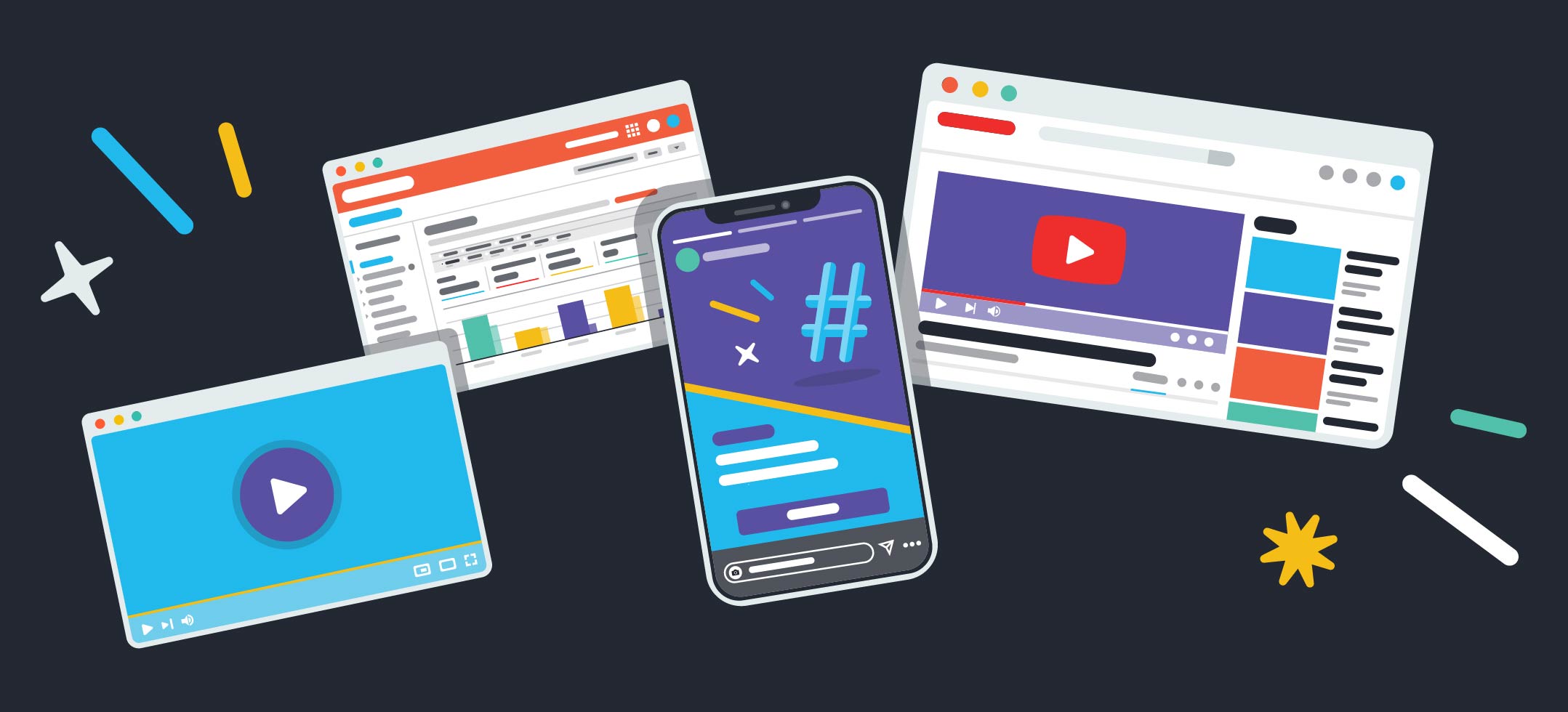
New Social Media Marketing Tools to Promote Your Brand
If you’re a hard-working ecommerce business merchant, learning new ways to get your products in front of new and existing customers is likely always on your radar.
In the last little while, there have been a bunch of new social media features and platforms popping up that are worth knowing about—and worth marketing on. As an ecommerce merchant, these features and platforms could give your brand greater exposure and lead to an increase in sales—so what’s not to love?!
Let’s get started!
New Social Media Marketing Tools to Promote Your Brand
New Social Media Marketing Tool #1: YouTube Stories
YouTube Stories are a collection of short videos that last seven days. Viewers can watch them in their YouTube mobile app from the top of their subscription feed, some watch pages, or your YouTube homepage.
YouTube creators with more than 10,000 subscribers can create stories to engage their audience with organic, in-the-moment content. It’s a way to provide fresh content that viewers wouldn’t see otherwise without negatively impacting the discovery of your main uploads.
If you’re wondering whether YouTube Stories are worth your precious time, YouTube’s Creator Academy says those with active story feeds can speed up their weekly subscriber count by 8.5%.
Creators can also view the number of comments and views their stories receive during their seven-day lifecycle, making it simple to see what viewers engage with the most.
If you’re looking for a bit of inspiration, Taco Bell is an excellent example of a brand putting YouTube Stories to good use. They post brand-relevant wallpaper backgrounds when they launch their stories every Wednesday, referring to them as #wallpaperwednesday.
As for other kinds of brand promotion on YouTube Stories, you can:
- Advertise discounts lasting the lifetime of the story
- Give customers a sneak peek of your new products
- Take followers behind-the-scenes for a more immersive brand experience
Pros
- YouTube Stories are great for channels that have 10,000+ subscribers
- There’s ample opportunity to get creative and have some fun
- The success of your YouTube Stories doesn’t influence the discovery of your main uploads
- When done well, you can increase your subscriber count
Cons
- Fledgling channels can’t use YouTube Stories
- Content expires after seven days
The Best Type of Content to Post on Youtube Stories
- Limited-time promotions
- Quickfire “how-to” tutorials
- Sneak peeks at new products about to be launched
- Competitions and giveaways
- An immersive behind-the-scenes look at your brand
Keep in mind that you can always hang onto your YouTube Stories content and repurpose it on other social media platforms too, or combine a bunch of stories together to make a mainstream YouTube video.
New Social Media Marketing Tool #2: YouTube “Shorts”
Not to be confused with YouTube Stories, YouTube “Shorts” are a new way for creators and brands to make short and punchy videos (that are 15 seconds or less) from their mobile phones.
Launched in the US in March 2021 to rival TikTok videos, YouTube Shorts provide creators with a unique and fun way to create engaging content. Creators can use musical overlays and use accelerated or slowed down effects to create hands-free content via the YouTube mobile app.
It’s too early to say if advertorial opportunities are on the horizon but, at the time of writing, Shorts can’t be monetized. But, what we can say is that subscribers who watch your YouTube Stories get automatic access to your Shorts, too—so you practically have a built-in audience at your disposal!
It’s also worth noting that unlike YouTube Stories, Shorts don’t disappear.
Pros
- You can be part of something super new that’s still a growing feature
- You have the option to edit and stylize the videos to make them fun and engaging
- You can upload pre-created content from your smartphone’s camera
Cons
- It’s so new that it’s still developing—who knows how it will grow or if it’ll stick around for long
- 15 seconds is super-short, so you’ll have to get creative with how to use this medium
The Best Type of Content to Post on Youtube Shorts
- Quickfire, fun content
- Product launch teasers
- Taster content to entice customers to watch longer videos
- Content that’s aimed at Gen Z and/or Millennials
New Social Media Marketing Tool #3: TikTok
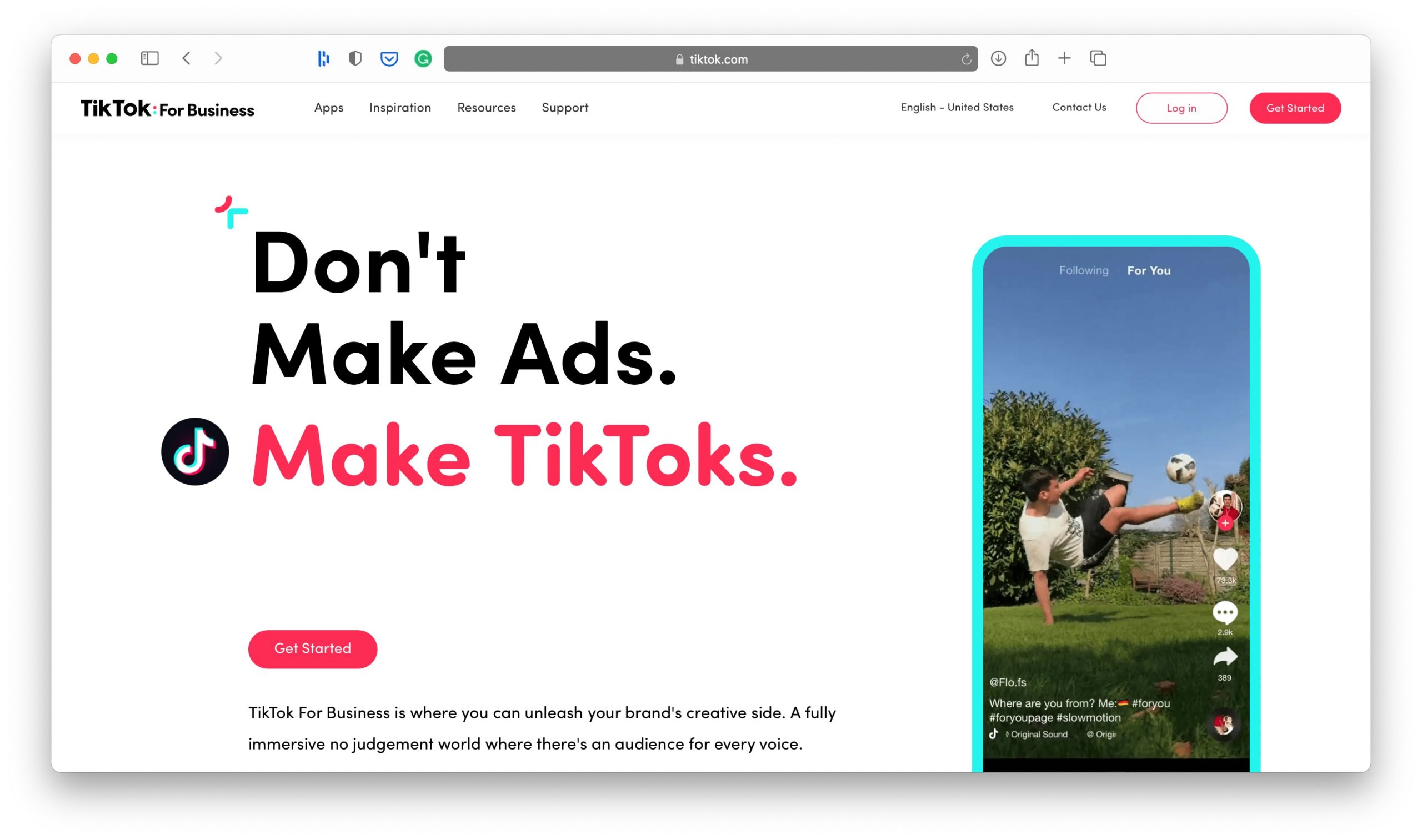
TikTok went viral when it launched back in 2016. By 2018, it was the fourth most downloaded social media app after Facebook, YouTube, and Instagram. Then in 2019 alone, it earned 500 million new users!
TikTok videos currently can’t be longer than 60 seconds (although an up-to 3-minute video feature is being rolled out) but content can be created on any topic. This platform is widely used by brands and is particularly popular with Gen Z and Millennials, and there are over 689 million active users worldwide.
This social media hub fast became a platform that brands embraced due to its quick virality factor. Since videos are so short, they get seen and shared quickly which can make them go viral fast, regardless of an account’s audience size.
And instead of traditional display ads, brands are exploring creative ways to generate user-generated content so their ads are more organic. Ads on TikTok come across less like “commercials” and more like the rest of the user-made videos on the platform, and users seem to like it that way.
So if you’re a brand with a small team or budget—don’t worry! Your TikTok brand content or ads don’t have to be super professional. In fact, it’s better if they’re not. Users there like to see real, organic content they can connect with rather than high-production commercials.
That said, you can run five different types of ads on TikTok:
- In-feed ads
- TopView
- Branded hashtag challenge
- Branded effects
- Brand takeover
You can learn more about TikTok ads here. TikTok can also help you target your ads to increase the likelihood of your content reaching its intended users.
Pros
- TikTok is embraced by celebrities, brands, and influencers alike, so it’s the place to be!
- It’s quick and easy to create and post fun and engaging content
- With millions of users, there’s enormous potential to extend your brand’s reach
- It’s the easiest social platform to get your content in front of users who aren’t already following you
- To boost brand exposure, you can also pay for TikTok ads
Cons
- TikTok is saturated with content, so there’s lots to compete with
- You can’t link videos back to your website
- Since users don’t have to follow your account to view your content, it can be challenging to build up a following
The Best Type of Content to Post on TikTok
- User-generated content
- Content aimed at younger target audiences, especially Gen Z and Millennials
- New product launches
- Celebrity tie-ins
- Hashtag challenges
- Fun videos set to music
New Social Media Marketing Tool #4: Clubhouse

(Source)
Clubhouse is a new invitation-only, audio-based social media app where users participate in live podcast- or radio-like content. Users with an invite can sign up to Clubhouse and join different “rooms” to listen in on conversations, discussions, and talks. Launched in April 2020, the app is populated by users ranging from the rich and famous (think Bill Gates, Elon Musk, Oprah, Drake, and Gayle King) to the average Joe. It’s a mobile-only app that started out on iOS but is now available on Android, too.
Here’s how it works: Clubhouse has a series of virtual “rooms” where a chat is hosted by a user who moderates the content. Any user with something to say has to “raise” their hand and be invited by the moderator to speak.
While the app has faced criticism in the past for some rooms or users discussing inappropriate topics, there are, however, tons of experts on the app sharing their knowledge and expertise on numerous topics in different rooms. If you’re fortunate enough, you may also get picked to ask a question or join in the conversation. There are also talent shows, “meet new people” rooms, and more. It’s a versatile place for individuals and brands alike.
Bite Toothpaste is one example of a business using Clubhouse to their advantage. They sponsored a room where Bite’s founders told their start-up story and scored themselves around 30 new customers. Another example is when former Focus Brands CEO, Kat Cole, hosted her weekly office hours Clubhouse room, she mentioned their bakery brand Cinnabon and told listeners that if they wanted some, she’d send them some. This was an effective way to raise brand awareness and build brand excitement in an organic way.
Pros
- Clubhouse provides access to well-known people and experts
- Its exclusivity attracts a more high-profile and vetted audience
- Its intimate feel provides an opportunity to organically grow brand and product awareness
- You can sponsor a room to get your brand name out there
Cons
- It’s audio-only, so that may impede brand awareness or exposure
- It’s invitation-only, so you have to source an invite to use the app
- The user-base may be limited due to the invite-only model
- Conversations are live and ephemeral—they’re not recorded for playback
- It’s new, and like other newly-launched tools, it hasn’t been around long enough to test the long-term success
The Best Type of Content to Post on Clubhouse
- Live conversations about a wide range of topics, including new products
- Sharing brand stories about how your business started and is growing
- Generating interest for events and promotions
- Launching word-of-mouth campaigns
- Raising brand awareness by sponsoring rooms or offering free products
New Social Media Marketing Tool #5: Twitter Spaces
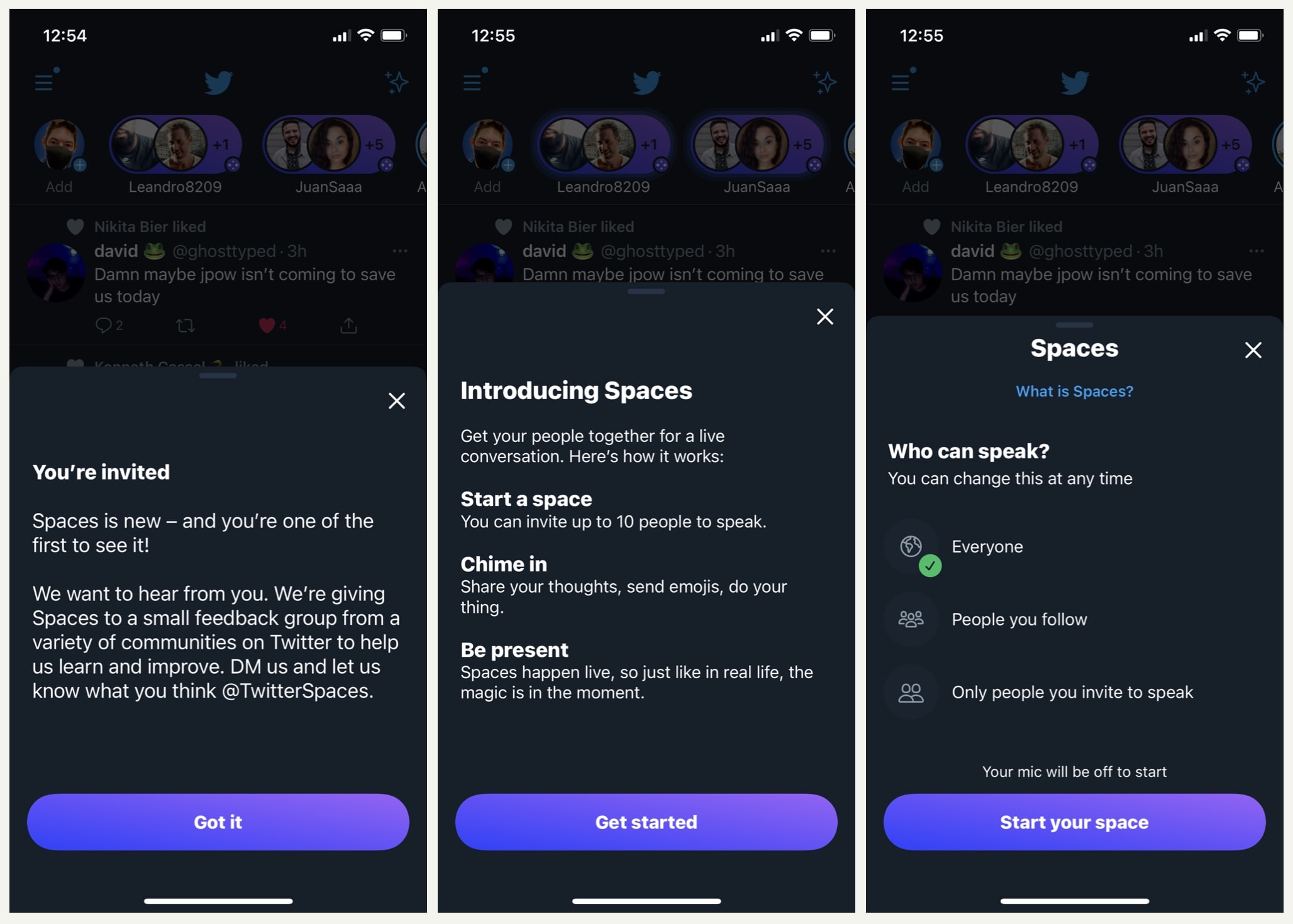
(Source)
If you’re looking for a non-membership version of Clubhouse, look to Twitter Spaces.
In November 2020, Twitter began testing Spaces with a limited number of users and then started rolling it out globally in early May 2021. Still in its early infancy, Twitter Spaces is a fresh way to host live audio conversations. Unlike Clubhouse, you don’t need an invite to join, but you do need 600+ followers in order to host a Space. Any Twitter user, however, can listen in.
Here’s how it works: Each Space has a host who moderates the discussion. Spaces are public, and any Twitter user can participate as a listener—even users who aren’t following the host. As a listener, you can be invited to a Space via a link in a DM, tweet, or email. Each Space can have up to 11 people speaking at any given time but an unlimited number of listeners.
Here’s what Twitter Spaces hopes to introduce in the long run:
- Ticketed spaces where hosts can generate income from their content
- Scheduled events with reminders so users can track what’s happening
- Co-hosting spaces to better manage speakers and participants
- Improvements to live captions to improve accessibility
Pros
- It’s more accessible than Clubhouse
- There’s already a large audience of active Twitter users to reach
- Twitter Spaces offers live captioning (the host just needs to turn on that feature)
- It’s available to any Twitter account with 600+ followers
Cons
- It’s public, which makes it easier for trolls to access the Spaces, however, hosts have the option to block and report users if need be
- Users need 600 followers or more to be able to host a Space
- So far, Twitter Spaces doesn’t have the same celebrity/expert reputation that Clubhouse has since anyone can use the feature
The Best Type of Content to Post on Twitter Spaces
- Live product launches
- Word-of-mouth campaigns to generate buzz around a topic or product
- Creating content for your target audience to connect with in real-time to establish more authentic connections
- Content that could convert random listeners into Twitter followers
- Talking about trends related to your business niche
Overall, there’s definitely more internet chatter now about social audio platforms and how they’re increasingly providing users with more custom content that just doesn’t happen with video content.
New Social Media Marketing Tool #6: LinkedIn Stories
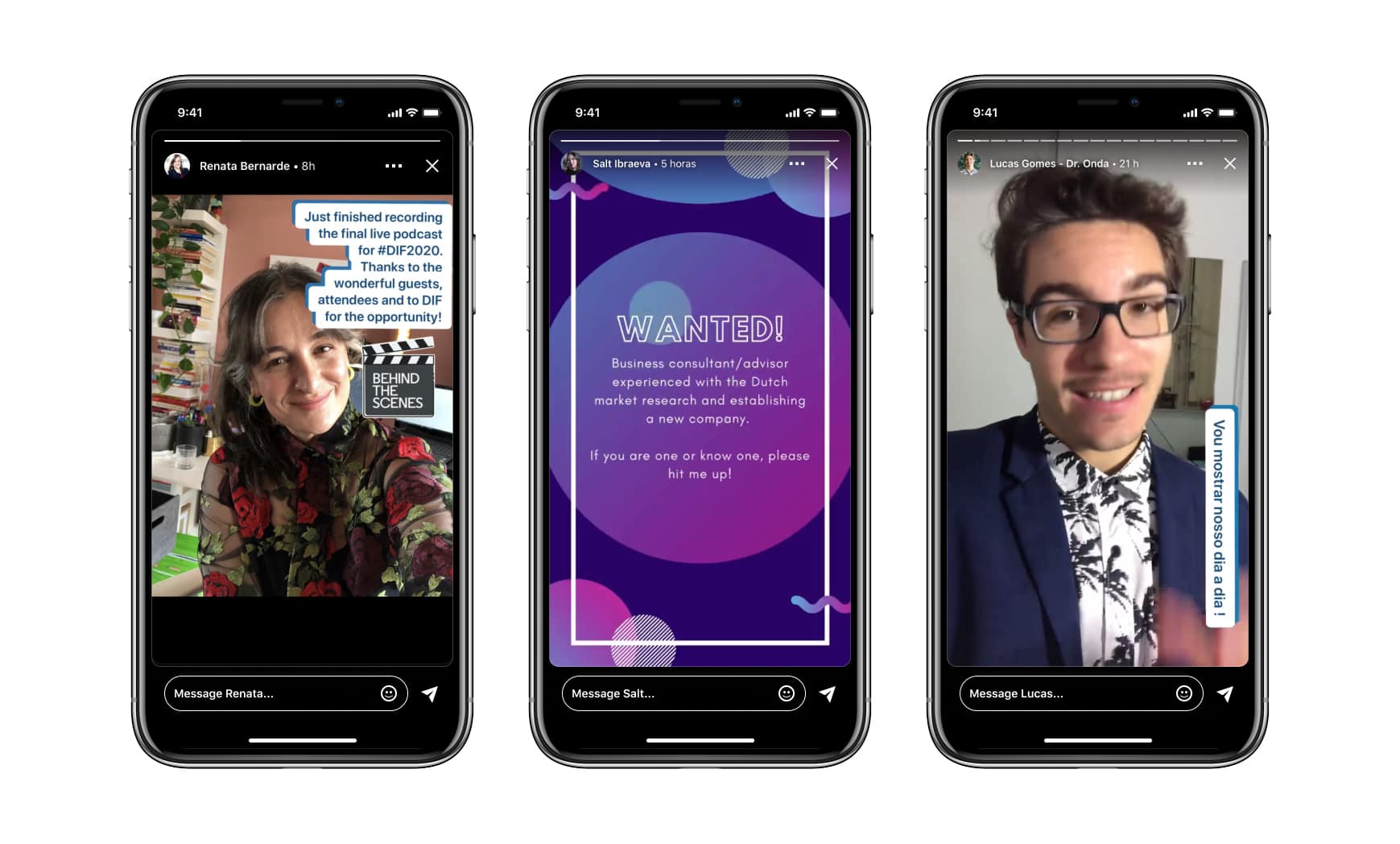
(Source)
If you’re interested in sharing professional updates about your business, LinkedIn Stories may be worth exploring. Much like Snapchat and Instagram, LinkedIn members can now post videos and photos lasting a maximum of 20 seconds. Each post is live for 24 hours before disappearing.
Available on the most recent version of LinkedIn’s mobile app, LinkedIn members can view stories posted by their connections or any pages and people they follow.
This is another great way for brands to connect with their audience and share business news or promote their brand. Given that LinkedIn is a platform where members usually go to find work and network, LinkedIn Stories is best suited to business-orientated types of content.
Examples of brands doing just that include Adobe. They used the LinkedIn Stories feature to share the knowledge they’ve gathered from their Digital Insights report. Ernst and Young also showed its more approachable, inclusive side by allowing their interns to take over the E&Y LinkedIn page and post relatable behind-the-scenes stories.
Pros
- LinkedIn Stories are a great way for brands to make their business more accessible
- Both photos and videos can be posted on LinkedIn Stories
- It can be used by individuals and businesses alike
- It’s an excellent way to share news, testimonials, promotions, insights, and more
Cons
- It can be challenging to strike the right tone between professional and accessible/approachable
- Since LinkedIn is oriented to professionals, not all types of content will work for the platform
- Reach on LinkedIn might not be as broad as it is on other social platforms since their niche is so targeted to professionals
The Best Type of Content to Post on LinkedIn Stories
- Giving users a behind-the-scenes look at your brand
- Sharing business tips and insights
- Sharing motivational content and quotes
- Providing sneak peeks of new products
- Sharing the latest/breaking news and announcements about your brand and niche
- Creating interactive content that engages viewers, such as online events and Q&As
New Social Media Marketing Tool #7: Instagram Reels

(Source)
Billed as Instagram’s response to TikTok, Reels are 15-second videos that users can record, edit, and share to their feed. Viewers can “like” your Reels, so you can get an idea if your content is hitting the mark or not. For Instagram Reel makers, it’s also possible to repurpose content on other platforms too (such as TikTok).
Launched in August 2020, Reels have been embraced by some pretty big brands. They can be used to:
- Educate your audience about your brand
- Showcase new products
- Share your brand’s personality and values
- Demonstrate why you’re different from your competitors
Pros
- You can increase your audience reach on Instagram
- Viewers can engage with your Reels to give you feedback
- Reels present an excellent opportunity to interact with a wider Instagram audience
- You can repurpose content from other social tools you’re already using
Cons
- There aren’t currently any advertising opportunities to boost your content
- Because of licensing issues, businesses can’t add music to their Reels
The Best Type of Content to Post on Instagram Reels
- How-to videos like product tutorials, assembly demonstrations, and unboxings
- Behind the scenes content, like “meet the team” videos or product sneak-peeks
- “Before and After” videos demonstrating products in action
- Content that tells your brand’s story
Overall, Instagram Reels are another marketing tool that brands can use to express themselves and get their brand in front of Instagram’s massive user base.
New Social Media Marketing Tool #8: Pinterest Stories
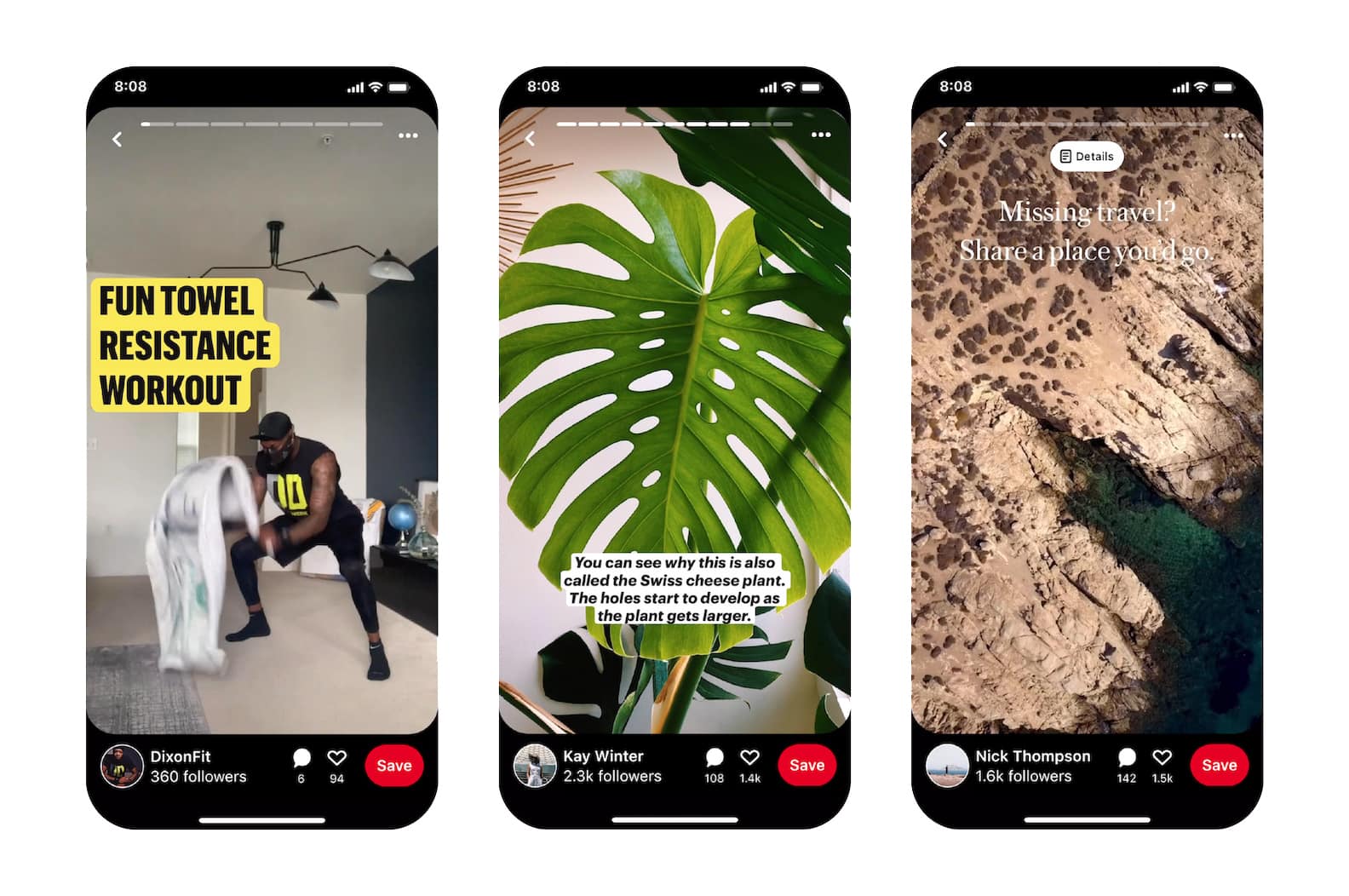
(Source)
Launched in September 2020, Pinterest Stories are a new type of pin and publishing choice for creators—which Pinterest calls “Story Pins.”
At the time of their launch, Pinterest described them as a “way for creators to tell dynamic and visual 60-second long stories with videos, voiceovers, and image and text overlay.”
Currently available to some Pinterest business accounts, users can share up to 20 pages of images, video, and text Story Pins. Also, unlike some of the other tools we’ve referred to in this article, Story Pins can be saved to Pinterest boards to be viewed later which increases their lifespan.
Pros
- They offer another means of telling your story without viewers needing to leave the platform
- Story Pins aren’t ephemeral—they can be pinned to boards which increases their chances of being seen
- They’re a great way to share videos on the Pinterest platform, which hasn’t been hugely video-friendly until recently
- Story Pins give you the opportunity to showcase your business to Pinterest’s vast audience of 459 million active monthly users
- Videos can last up to 60 seconds and users can post up to 20 pages at a time
Cons
- You can’t add links to your Pinterest Stories
- Users must have a Pinterest business account to access the feature
- As it’s a new feature, it may not be rolled out to all accounts yet
The Best Type of Content to Post on Pinterest Stories
- “How to” content, product tutorials, unboxings, and demonstrations
- Day in the life content, for example, of your small business
- Inspirational content on different topics like creativity, mental health, and goal setting
Are You Ready to Start Using the Latest & Greatest Social Media Tools?
Hopefully, you now have a better idea of how to use some of the most recent social media marketing tools to promote your brand. Each feature and tool on this list has its own set of pros and cons, and while we’re not advocating that you embrace them all, it may be worth your while to test one or two to see if they’re a good fit for your brand.



